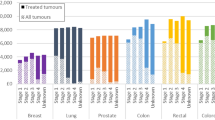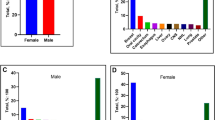Abstract
Objective
The study was conducted to examine factors associated with hospital deaths among a group of cancer patients.
Patients and methods
A retrospective chart review of the M. D. Anderson Cancer Center Tumor Registry was conducted. Participants were all adult cancer patients, residents of the State of Texas diagnosed and treated since January 1, 1990, and who died during the years 1999 and 2000. The study outcome was the site of death.
Main results
The inclusion criteria were met by 866 patients of whom 504 (58%) died in a hospital. The group included 489 (56%) men. A number of 641 (74%) were White, 104 (12%) Hispanic, 92 (11%) Black, and 29 (3%) of other origin. The majority, 501 (58%), had been diagnosed with stage IV disease, and the median survival time was 14 months. Multivariate logistic regression analysis showed patients diagnosed with hematologic cancers to be significantly more likely (p<0.001) of dying in hospitals, odds ratio [OR 2.88] and confidence interval [95% CI 1.79–4.63], women diagnosed with breast and gynecological cancers were significantly less likely (p=0.03) of dying at hospitals odds ratio [OR 0.64] and confidence interval [95% CI 0.42–0.96], when compared with patients diagnosed with other cancers. Lower household income per zip code of residency was marginally associated (p=0.06) with hospital deaths.
Conclusions
The study identified groups of cancer patients at risk of hospital death. These results should account when planning the allocation of hospital palliative care services as well as when informing policy decisions about health care financing and delivery of these services.
Similar content being viewed by others
References
Addington-Hall J, Altmann D, McCarthy M (1998) Which terminally ill cancer patients receive hospice in-patient care? Soc Sci Med 46:1011–1016
Anderson RAE (2003) The effect of revised populations on mortality statistics for the United States, 2000. Natl Vital Stat Rep 51:1–5
Anonymous (2000) Population, housing units, area, and density (geographies ranked by total population), vol 2004. US Census Bureau
Anonymous (2003) Directory of hospices and home health agencies in Texas. Texas Cancer Data Center, Houston, TX
Bast R, Kufe D, Pollock R, Weichselbaum R, Holland J, Frei E, Gansler T (2000) Cancer medicine, 5th edn. B.C. Decker, Inc., London
Bauduer F, Capdupuy C, Renoux M (2000) Characteristics of deaths in a Department of Oncohaematology within a general hospital. A study of 81 cases. Support Care Cancer 8:302–306
Brooks S, Chen T, Ghosh A, Mullins C, Gardner J, Baquet C (2000) Cervical cancer outcomes analysis: impact of age, race, and comorbid illness on hospitalization for invasive carcinoma of the cervix. Gynecol Oncol 79:107–115
Bruera E, Russell N, Sweeney C, Fisch M, Palmer L (2002) Place of death and its predictors for local patients registered at a comprehensive cancer center. J Clin Oncol 20:2127–2133
Bruera E, Sweeney N, Russell JW, Palmer L (2003) Place of death of Houston area residents with cancer over a two-year period. J Pain Symptom Manage 26:637–643
Costantini M, Camoirano E, Madeddu L, Bruzzi P, Verganelli E, Henriquet F (1993) Palliative home care and place of death among cancer patients: a population-based study. Palliat Med 7:323–331
Dawson N (1991) Need satisfaction in terminal care settings. Soc Sci Med 32:83–87
De Conno F, Caraceni A, Groff L, Brunelli C, Donati I, Tamburini M, Ventafridda V (1996) Effect of home care on the place of death of advanced cancer patients. Eur J Cancer 32A:1142–1147
Emanuel L, Von Gunten C, Ferris F (2000) Gaps in end-of-life care. Arch Fam Med 9:1176–1180
Foley K, Gelband H (2001) Improving palliative care for cancer. Institute of Medicine and National Research Council, Washington, DC
Fox E, Landrum-McNiff K, Zhong Z, Dawson N, Wu A, Lynn J (1999) Evaluation of prognostic criteria for determining hospice eligibility in-patients with advanced lung, heart, or liver disease. JAMA 282:1638–1645
Gallo W, Baker M, Bradley E (2001) Factors associated with home versus institutional death among cancer patients in Connecticut. J Am Geriatr Soc 771–777
Gallup Organization Survey (1996) Knowledge and attitudes related to hospice care. Commissioned by the National Hospice Organization
Ghafoor A, Jemal A, Ward E, Cokkinides V, Smith R, Thun M (2003) Trends in breast cancer by race and ethnicity. CA Cancer J Clin 53:342–355
Goodlin SJ, Winzelberg GS, Teno JM, Whedon M, Lynn J (1998) Death in the hospital. Arch Intern Med 158:1570–1572
Greer D, Mor V, Morris J, Sherwood S, Kidder D, Birnbaum H (1986) An alternative in terminal care: results of the national hospice study. J Chronic Dis 39:9–26
HCUPnet (2002) Healthcare cost and utilization project. Agency for Healthcare Research and Quality, Rockville, MD
Izquierdo-Porrera A, Trelis-Navarro J, Gomez-Batiste X (2001) Predicting place of death of elderly cancer patients followed by a palliative care unit. J Pain Symptom Manage 21:481–490
Kochanek KD, Smith BL (2004) Deaths: preliminary data for 2002. Natl Vital Stat Rep 52:1–47
Lackan NA, Ostir GV, Freeman JL, Mahnken JD, Goodwin JS (2004) Decreasing variation in the use of hospice among older adults with breast, colorectal, lung, and prostate cancer. Med Care 42:116–122
Omara AN, Arenella C (2001) Minority representation, prevalence of symptoms, and utilization of services in a large metropolitan hospice. J Pain Symptom Manage 12:290–297
Petrisek A, Mor V (1999) Hospice in nursing homes: a facility-level analysis of the distribution of hospice beneficiaries. Gerontologist 39:279–290
Pritchard R, Fisher E, Teno J, Sharp S, Reding D, Knaus W, Wennberg J, Lynn J (1998) Influence of patient preferences and local health system characteristics on the place of death. J Am Geriatr Soc 46:1242–1250
Tang ST, McCorkle R (2001) Determinants of place of death for terminal cancer patients. Cancer Investig 19:165–180
The Dallas Morning News L (2001) Texas almanac 2002/2003. Texas A&M University Press Consortium, Dallas, TX
Weitzen S, Teno JM, Fennell M, Mor V (2003) Factors associated with site of death: a national study of where people die. Med Care 41:323–335
White K, Cochran C, Patel U (2002) Hospital provision of end-of-life services who, what, and where? Med Care 40:17–25
Acknowledgements
The authors wish to thank Charissa Higginbotham and Lore Feldman for their editorial contributions which enhanced the quality of this manuscript.
Author information
Authors and Affiliations
Corresponding author
Additional information
We want to state that no financial support was provided for this study
Rights and permissions
About this article
Cite this article
Cárdenas-Turanzas, M., Grimes, R.M., Bruera, E. et al. Clinical, sociodemographic, and local system factors associated with a hospital death among cancer patients. Support Care Cancer 14, 71–77 (2006). https://doi.org/10.1007/s00520-005-0819-2
Received:
Accepted:
Published:
Issue Date:
DOI: https://doi.org/10.1007/s00520-005-0819-2




